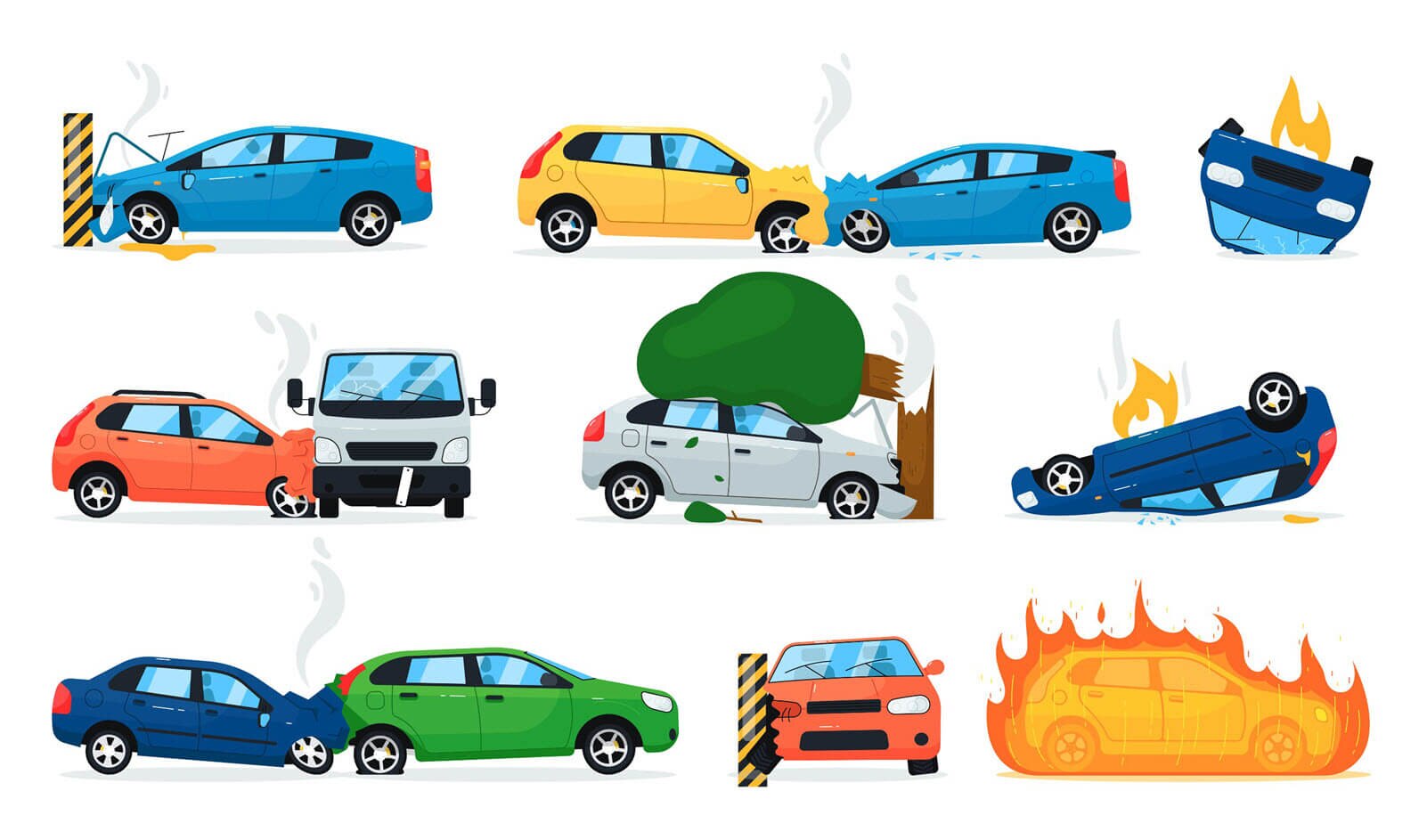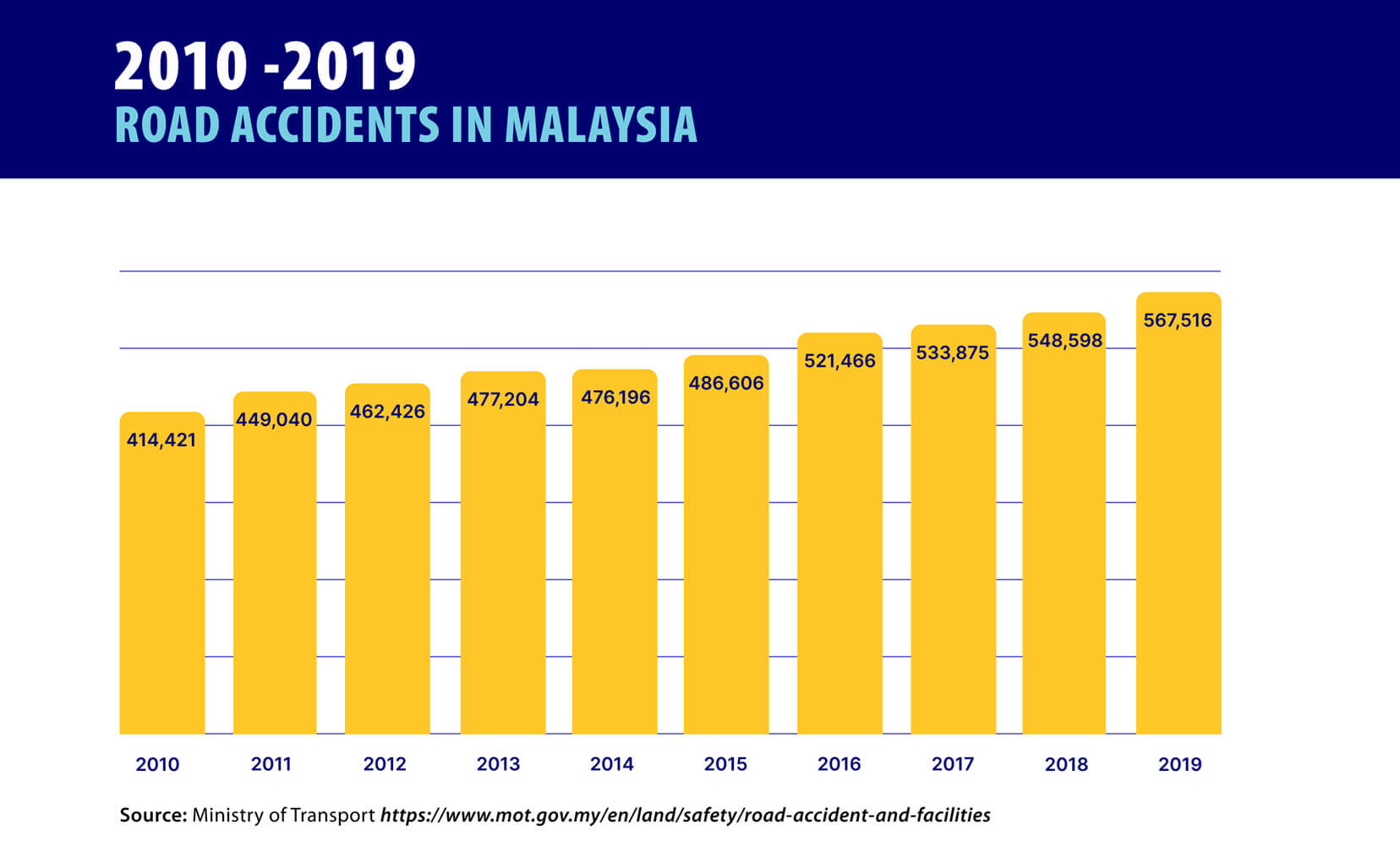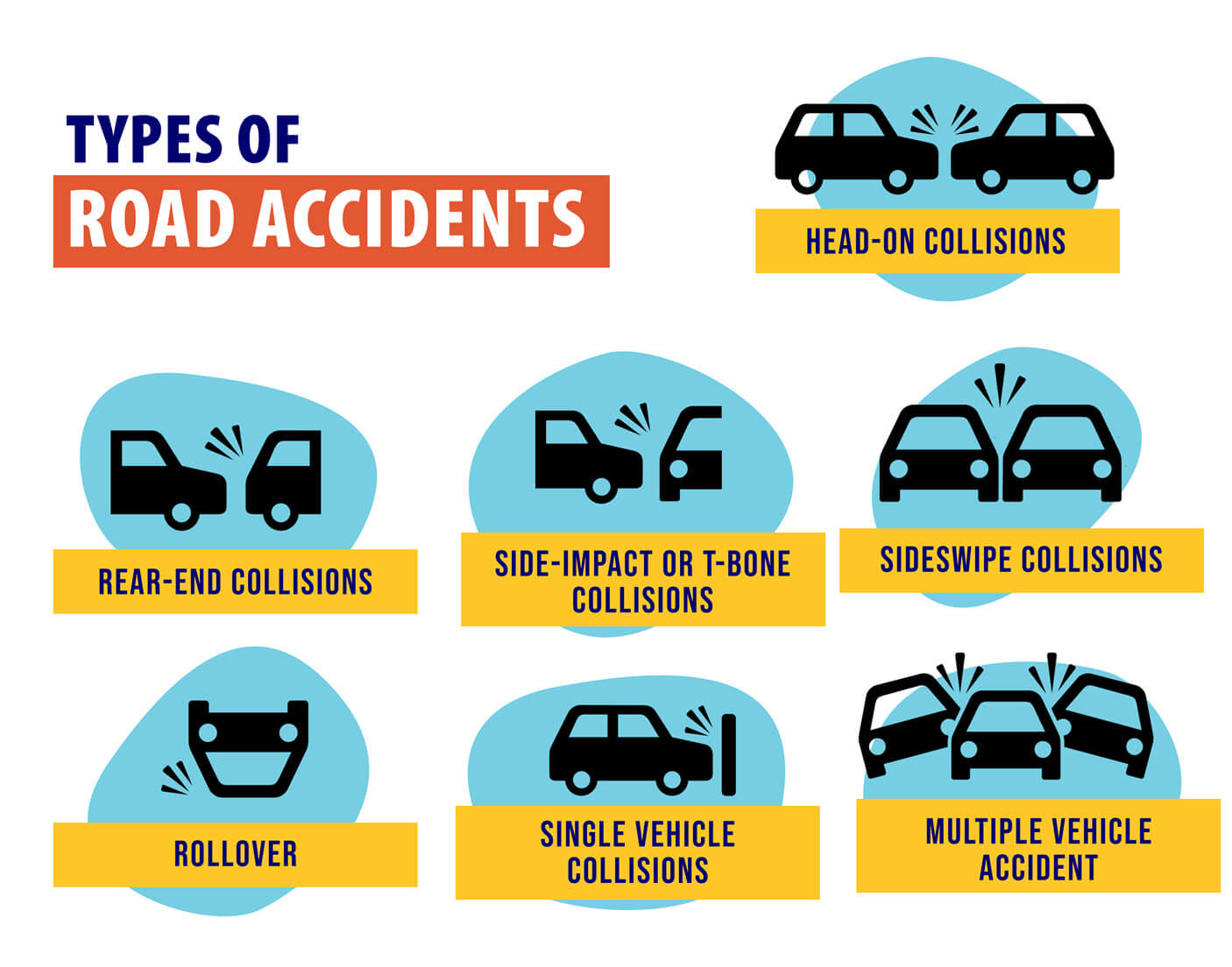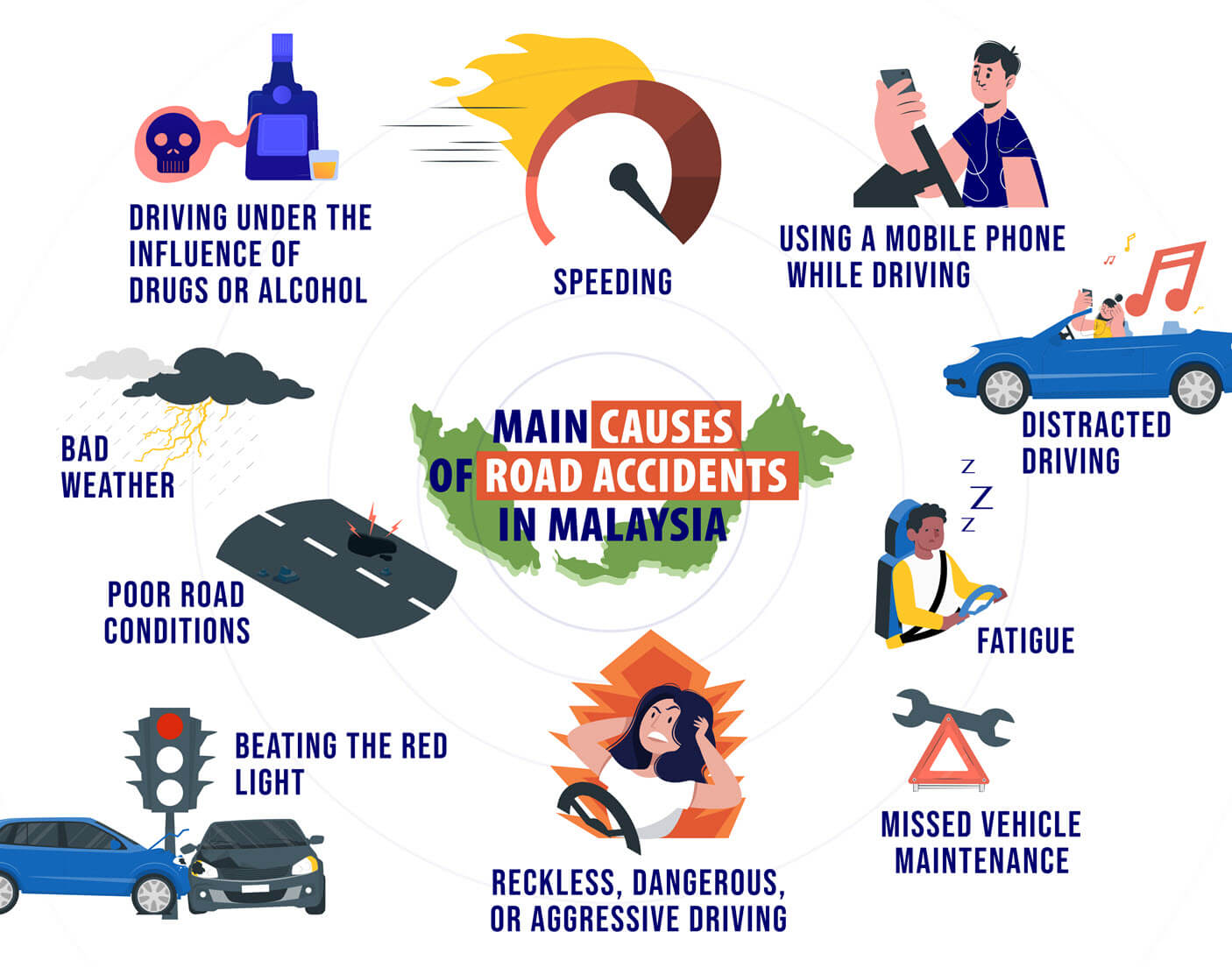The 10 Most Common Causes of Road Accidents in Malaysia & How to Prevent Them

Road accidents have been increasing steadily in Malaysia over the last few years, despite numerous efforts by the authorities to improve safety.
Road Accident Statistics
The Ministry of Transport reported a steady rate of road accidents from 2010 to 2019, with over 6,100 fatalities in 2019. In 2020 and 2021, Malaysia's Movement Control Order led to fewer accidents, but they were still concerning.
The accident rates reveal something crucial; accidents can result in fatalities, severe injuries, mental trauma, and financial loss, so we need to focus on preventing them.
Many accidents occur because of external or environmental factors, such as bad weather, which we, drivers, cannot control. However, subjective hazards, i.e., human error, cause most accidents. We can prevent these if we take the appropriate precautions.

Types of Road Accidents
An accident occurs when a vehicle hits a person, object, or another vehicle, causing injury, fatality, or damage.
In general, accidents can be classified as major or minor based on their severity. Although every accident is unique, the severity can be determined by the type of collision, risk factors and impact pattern on the vehicle.
The following are seven types of impact patterns in an accident. Understanding them could help you avoid accidents.

1. Head-on Collisions
Head-on collisions are usually the most severe type of accident, as they involve a direct impact between two vehicles travelling in opposite directions. These types of accidents often result in road fatalities, particularly at high speeds.
2. Rear-end Collision
Also known as a back collision, rear-end collisions happen when one vehicle collides with the back of another vehicle that is stationary or moving more slowly. A sudden acceleration of the rear vehicle or deceleration of the front vehicle can also cause this type of collision.
3. Side-impact or T-Bone Collisions
When two cars collide at a perpendicular angle, they are referred to as a T-bone crash or side-impact collision. Usually, this type of collision occurs when a vehicle jumps a traffic light at an intersection.
4. Sideswipe Collisions
Sideswipe occurs when one vehicle collides with the side of another vehicle traveling in the same direction. Commonly, the drivers of other vehicles do not notice the vehicle drifts or skids into your lane without their knowledge. When a vehicle sideswipes, it can lose control and careen off the road or collide with another vehicle, person, or object.
5. Rollover
During a rollover accident, a vehicle flips over, tumbles, or lands on its roof. "Turned turtle" is commonly used to describe a vehicle that experienced a rollover accident. These crashes are usually violent and result in severe damage, injuries, or even death.
6. Single Vehicle Collisions
Most accidents involve one vehicle and typically occur when the drivers lose control of their vehicle and collide with an object or spin off the road. Often, single-vehicle accidents are caused by driver's errors, such as speeding or driving under the influence.
7. Multiple Vehicle Accident
When three or more cars are involved in a single collision, it is a multiple-vehicle accident. A chain reaction from the first collision usually leads to a vehicle pileup.
Top Accident Causes
Taking steps to prevent accidents begins with understanding the causes and risks. The following are the ten most common causes of road accidents in Malaysia:

1. Speeding
Speeding is one of the most common factors of road accidents. It is also one of the most preventable, as it is entirely under the driver's control. Speeding not only increases the chance of an accident happening but also makes the consequences more severe.
However, many drivers continue to speed, despite realising the dangers. One of the reasons for this is that speeding can be hard to resist, especially when the traffic light is green and there are no other cars on the road. Another reason is that drivers may not be aware of the posted speed limit or think they can safely exceed it by a small margin.
When a driver is speeding, they are less able to react to unexpected situations, and the impact of a collision is more likely to be fatal to the driver, passengers, or pedestrians.
Faster driving leads to higher collision speeds, increasing impact force. For example, if a car crashes into pedestrians at 40km/h, about 90% will survive, but if the speed increases to 100km/h, only 10% of pedestrians would survive due to the more substantial impact.
Also, you can be fined or even jailed if caught speeding.
Safeguard yourself:
So next time you're tempted to go above the speed limit, remember that the risks far outweigh the rewards. Plan your journey to allow extra time, and drive within the posted speed limit.
2. Using a Mobile Phone While Driving
Using a mobile phone while driving is dangerous. It increases your chance of being involved in road traffic accidents by up to four times.
A study also showed that drivers who speak on their mobile phones while driving have an 18.1% slower reaction time compared to those who don't use them. Even hands-free devices are not safe, as they can still cause distraction.
When using your phone, you're taking your eyes off the road and your hands off your steering wheel. This means you're less able to control the car if something unexpected happens.
Additionally, using a mobile phone while driving can lead to a hefty fine or jail time. So, it's not worth the risk!
Safeguard yourself:
While it's legal to talk on your phone using a hands-free set or speakerphone while driving, it's recommended that you stop before you make a call and pull over to a safe location first.
And if you're expecting a call or text, let your passengers know they'll need to answer it for you.
3. Distracted Driving
Distracted driving is any activity that takes your attention away from the road. It can be anything from talking to passengers, eating and drinking, fiddling with the car stereo, or looking at something outside the car.
Texting and calling are some of the most common and dangerous forms of distracted driving, and we covered that above. But even something as innocuous as changing the radio station can make you lose focus and cause an accident.
Loud music can also be distracting, so ensure your radio is set to a comfortable volume. Listening to loud music is also a distraction, so you should ensure that your radio is at a comfortable volume.
Safeguard yourself:
To avoid being distracted while driving, ensure you're prepared before starting your journey. For example, change the music playlist, adjust your seat, and do anything else that needs to be done before you start driving.
Once you're on the road, resist the urge to fidget with anything else. Keep your eyes on the road ahead.
4. Reckless, Dangerous, or Aggressive Driving
Reckless driving is when a driver takes unnecessary risks on the road. This can include speeding, tailgating, not using the signal lights, weaving in and out of traffic, making unsafe and abrupt lane changes, running red lights, or even driving against the traffic flow.
Unfortunately, these dangerous behaviours are too common, often leading to accidents. In 2021, 807 accidents* were caused by drivers going against the traffic flow. These accidents resulted in 29 fatalities and 712 cases of damage. (*source: https://www.thestar.com.my/news/nation/2021/09/28/wrong-way-drivers-caused-807-accidents-since-january-dr-wee-tells-dewan-rakyat)
Reckless driving endangers the driver, passengers, and other road users. It's one of the leading causes of accidents and fatalities on Malaysian roads.
Safeguard yourself:
The best way to avoid being involved in an accident is to drive defensively. This means going at a safe speed, keeping a lookout for other road users, and being prepared to stop or take evasive action if necessary.
Always keep an eye out for street signs so you know which direction you need to go and get into the right lane when making a turn, so you won't be caught off-guard, especially in an unfamiliar area.
Be aware of blind spots and use your signal light to give other drivers adequate time to react when changing lanes, especially in traffic congestion.
If someone is driving recklessly and endangering other road users, the best thing to do is to keep your distance and let them pass. Please do not attempt to overtake or stop the impatient driver, as this could escalate the situation and lead to an accident.
5. Beating The Red Light
Running a red light is one of the most common and dangerous traffic offenses, and it is worth being mentioned on its own. It's also illegal and can lead to a fine or imprisonment.
It puts the driver at risk of being involved in an accident and endangers other road users who may be crossing the intersection.
Safeguard yourself:
The best way to avoid being involved in an accident is always to obey traffic lights. This means stopping completely when the light is red and only proceeding when it turns green.
If you're approaching an intersection and see that the traffic light is about to turn red, slow down and stop before the line. Do not try to speed through the intersection.
If you're already at the intersection when the light turns red, you should continue through it and only stop if it's safe to do so. Do not reverse or make a U-turn, as this could lead to an accident.
It is also important to be aware of other motorists who might want to beat the red light. Once the lights have turned green for your lane, take a moment to watch whether traffic from other directions is trying to beat the red light.
Always give way to pedestrians crossing the road, even if you have the right of way.
6. Driving Under the Influence of Drugs or Alcohol
In Malaysia, driving while under the influence of drugs or alcohol is illegal. This law is strictly enforced. Under Section 45A of the Road Transport Act 1987, offenders can be fined between RM10,000 to RM30,000 and be jailed for up to two years.
Drunk driving is one of the leading causes of fatal accidents, as it impairs a driver's ability to make sound decisions and react quickly to changing conditions on the road. Not only does drunk driving put the driver at risk, but it also endangers the lives of other vulnerable road users.
Safeguard yourself:
The best way to avoid accidents is never to drink or take drugs before driving. If you're drinking alcohol, have a designated driver who can take you home safely.
Be sure to check the label of any medicine you have been prescribed to determine whether there are any warnings about drowsiness or recommendations not to operate heavy machinery while taking it. No matter how small the dose is, it is not safe to take these medications and drive. Generally, the effect lasts at least eight hours.
If you see someone driving under the influence of drugs or alcohol, the best thing to do is to keep your distance and call the police. Do not attempt to stop or confront them, as this could lead to a dangerous situation.
Lastly, never get into a car with a driver who has been drinking or taking drugs.
7. Fatigue
Fatigue is a familiar enemy for anyone who has driven for an extended period. Long hours on the road can take their toll, making it difficult to concentrate and leading to drowsiness and even micro-sleep.
Micro-sleeping is extremely dangerous because you can veer off course during the few seconds you inadvertently close your eyes. This could cause a collision before you even realise what's happening.
Safeguard yourself:
To combat this danger, taking breaks regularly and staying hydrated are essential.
If possible, take a nap before continuing your journey. If you cannot take a nap, make sure you stop at regular intervals to take a break and stretch your legs.
Avoid driving late at night or early in the morning, as this is when fatigue is most likely to set in. If you must go during these times, ensure you're well-rested before setting out.
8. Bad Weather
Heavy rains can quickly lead to dangerous driving conditions. Not only does rainfall reduce visibility, but it can also cause roads to become slick and slippery.
Wet roads can make it difficult to brake or steer, and cars may even begin to hydroplane. Hydroplaning occurs when a layer of water builds up on the road surface, causing your car's tyres to lose contact with the road surface and your steering wheel to feel light. Brakes will not be responsive in this situation.
Hydroplaning happens more often as your speed increases, which is dangerous since you do not have control over your car.
Strong winds can also pose a serious hazard, particularly for larger vehicles. High winds can make it challenging to maintain control of a car and even cause vehicles to be blown off course.
Safeguard yourself:
Although we can't control the weather, we can take things slowly and be extra cautious. Remember to turn on your headlights to increase your visibility to other drivers if it is dark and raining.
If possible, avoid driving in heavy rain or strong winds. If you must drive in these conditions, take things slowly and be extra cautious.
Never drive through the flooded road and avoid speeding on wet roads.
Keep an eye on the weather forecast and the current road safety situation before setting out on a long journey.
9. Poor Road Conditions
Bad road conditions are another major factor in accidents. Potholes, loose gravel, and other road hazards can cause drivers to lose control of their vehicles and collide with other cars or objects.
In some cases, poor road conditions can even lead to rollovers. Motorcycles are more susceptible to road hazards than other vehicles, as they have only two points of contact with the road. This can make it difficult to avoid obstacles and maintain control on uneven surfaces.
Uneven lanes, missing guardrails, or even faint road lines are common causes of road traffic injuries in Malaysia. These conditions can cause confusion and panic for drivers, leading to accidents.
Safeguard yourself:
Be aware of typical road hazards in your area and take extra care when driving over them.
Pay attention to the condition of the roads, and be on the lookout for potholes, loose gravel, construction signs, and other hazards.
If possible, avoid driving on poorly maintained roads. If you must move on these roads, take things slowly and be extra cautious.
Motorcyclists should exercise extra caution when riding on uneven surfaces.
You can also do your part by reporting any road hazards to authorities so that they can repair the roads as soon as possible.
10. Missed Vehicle Maintenance
If a car is not adequately maintained, it can be more likely to experience mechanical failures. This can lead to accidents, as vehicles may lose power or control while on the road.
Everyday maintenance issues that cause accidents are flat tyres, faulty brakes, and engine problems. Also, leaving bald tyres, thinning brake pads, or low engine oil unattended could cause accidents if they are not immediately addressed and fixed.
Safeguard yourself:
Regularly check your vehicle for potential maintenance issues. If you notice any problems, make sure to get them fixed as soon as possible.
Always keep your tyres properly inflated and in good condition. Faulty brakes are one of the most common causes of accidents, so check them regularly.
If your car breaks down while on the road, pull over to a safe area and call for help. Do not try fixing the problem yourself, as this could worsen the situation.
Get Fully Protected
There are many other factors contributing to road accidents besides those listed above. In most cases, you can prevent accidents by being a defensive driver, but sometimes unfortunate events still happen.
Having adequate motor insurance coverage is critical given all the risks of driving. A good policy from a reputable insurance company will cover your losses in the event of an accident.
Kurnia offers a wide range of motor insurance policies for Malaysian drivers. The coverage comes with fully customisable add-ons, so you can find one that suits you best.
Disclaimer: This blog post is strictly for informational purposes, and should not be taken as advice of any kind. Kurnia disclaims all responsibility for any losses resulting from reliance on the information contained in this article.